The Haswell Ultrabook Review: Core i7-4500U Tested
by Anand Lal Shimpi on June 9, 2013 9:00 AM ESTGPU Performance
With a modest increase in EU hardware (20 EUs up from 16 EUs), the Intel HD 4400 GPU in the Core i7-4500U I’m testing today isn’t tremendously faster compared to the HD 4000 in the i7-3517U. On average I measured a 15% increase in the subset of game tests I was able to run in Taipei, and a 13% increase in performance across our 3DMark tests. The peak theoretical increase in performance we should see here (taking into account EU and frequency differences) is 19%, so it doesn’t look like Haswell is memory bandwidth limited just yet.
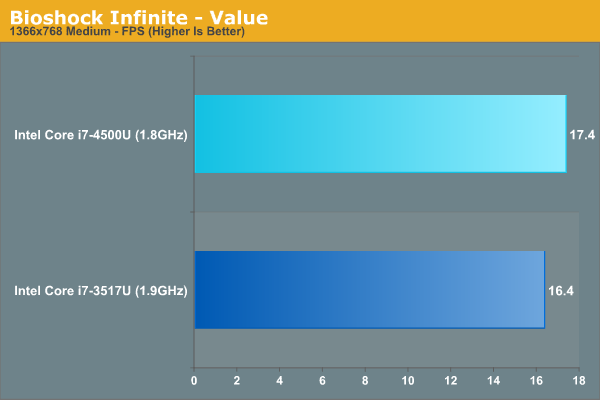
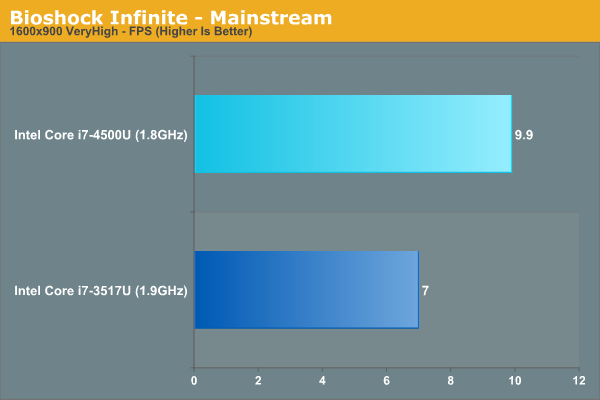
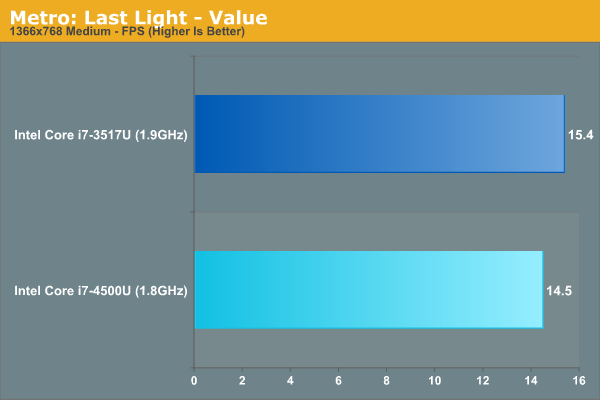
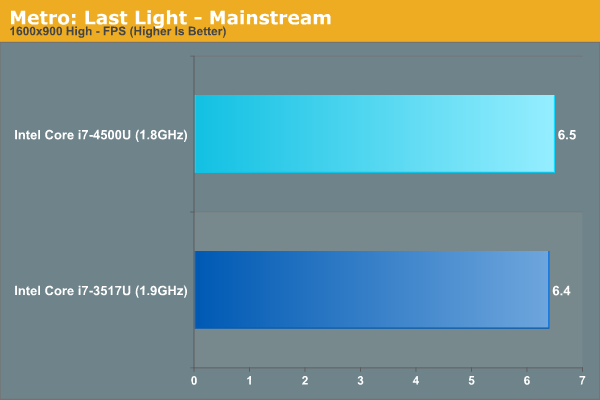
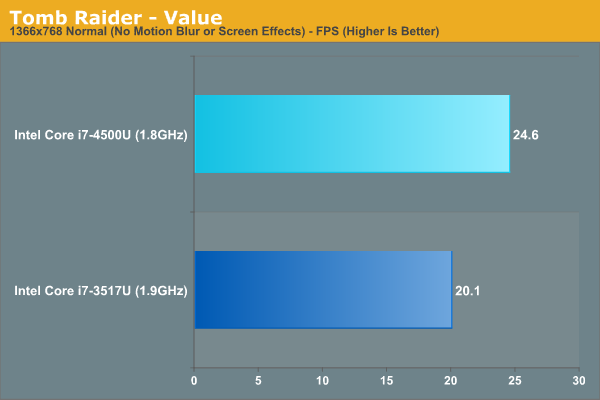
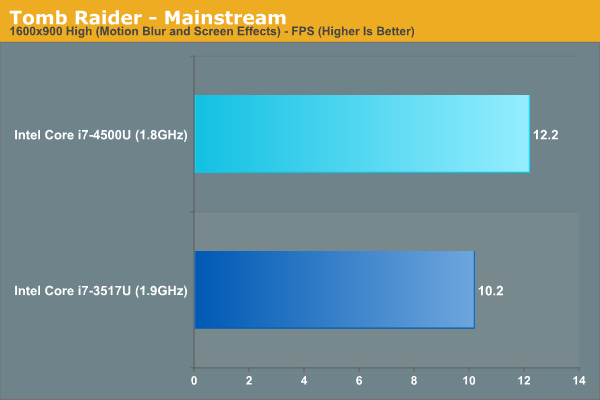


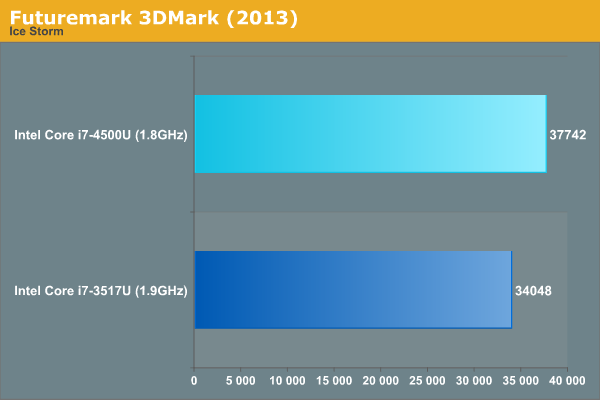
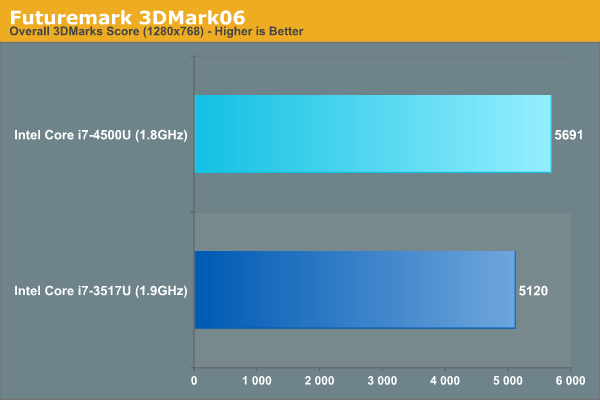
If we throw 35W Trinity into the mix, HD 4400 gets closer but it's still far away from 35W Trinity performance:
| GPU Performance Comparison | ||||||
| Metro: LL - Value | Metro: LL - Mainstream | BioShock Infinite - Value | BioShock Infinite - Mainstream | Tomb Raider - Value | Tomb Raider - Mainstream | |
| Core i7-3517U | 15.4 fps | 6.0 fps | 16.4 fps | 7.0 fps | 20.1 fps | 10.2 fps |
| Core i7-4500U | 14.5 fps | 6.5 fps | 17.4 fps | 9.9 fps | 24.6 fps | 12.2 fps |
| A10-4600M | 16.8 fps | 8.0 fps | 25.8 fps | 10.0 fps | 30.1 fps | 12.7 fps |
For light gaming, Intel’s HD 4000 was borderline reasonable. Intel’s HD 4400 takes half a step forward, but it doesn't dramatically change the playability of games that HD 4000 couldn't run well. Personally I’m very interested to see how the 28W Iris 5100 based Haswell ULT part fares later this year.










87 Comments
View All Comments
Freddo - Sunday, June 9, 2013 - link
I wonder if this CPU is powerful enough to run the PS2 emulator PCSX2 well, it require a somewhat decent CPU.bakedpatato - Sunday, June 9, 2013 - link
So the M series socketed Mobile Haswells are not getting S0ix?stevechippy - Sunday, June 9, 2013 - link
Correct, but there are U-series 28W TDP parts that aren't in the Ultrabook bracket AFAIK.Kevin G - Sunday, June 9, 2013 - link
Typo on page 7 on the Tomb Raider 1600 x 900 test graph: "Motion Blue".http://images.anandtech.com/graphs/graph7047/55515...
Ryan Smith - Monday, June 10, 2013 - link
Thanks!name99 - Sunday, June 9, 2013 - link
"The shift of consumer dollars to smartphones and tablets instead of notebooks and desktops won’t be reversed, but a good launch here might at least help keep things moving ok until Silvermont, BayTrail and Merrifield can show up and fill the gaps in Intel’s product stack."I love you Anand, and I love your tech analysis. But it might be worth your team acquiring a business analyst, or at least asking those sorts of questions of your informants.
Silvermont does not "fill the hole in Intel's product stack" because that hole is business-based not tech-based. We saw the prices of Haswell a few days ago --- $250 and way up. Meanwhile the price of a high-end ARM SoC is, what, $20? That's one hell of a difference.
The problem intel faces is that, for many purposes, it's perfectly adequate to pay for the $20 ARM CPU rather than the $250 Intel CPU. Silvermont and the whole Atom strategy, rather than making things better make things worse. Yes, now maybe Intel captures $20 from sale of an Atom --- but that Atom is ALSO able to replace Haswell (or at least lower-end but still more expensive Intel CPUs). The SMART Intel strategy would have been to acquire an ARM ISA license, making competitive ARM CPUs at $20 (so you still capture from that market) but at least avoid competing so directly with your more expensive line.
Intel's problems from here on out are business problems. They have to compete with an architecture that is simple enough that Apple could put together a competitive CPU starting from scratch in two years, and they have to do so using an architecture that is so complicated it took Intel 5 years to out together a competitive CPU. Meanwhile they can't charge Haswell prices to maintain the massive parallel design teams that are required to create these ever more sophisticated x86 designs.
(And, to make life even worse, apart from the myriad own goals Intel has inflicted, they have MS in the background insisting on its charges for Windows x86, one more drag on the sale x86 in the tablet market.)
I don't think things are nearly as rosy for Intel as do you. Technically yes, they are well-positioned right now. But they seem to be in the position of DEC or IBM in the early 80s --- technically superb, but with an extremely problematic business model. And it's business model that determines the future, more than technology...
rwei - Sunday, June 9, 2013 - link
IIRC Intel does have a full ARM license. But supporting ARM by making ARM parts competitive with Intel's x86 ones would be a blow to their future ability to extract economic rent for x86, as more software targeted at ARM became available.Much preferable to decisively beat ARM for 1-2 generations with x86 parts - if they can manage it.
peterfares - Monday, June 10, 2013 - link
ARM is going to keep getting better and better with or without Intel. It might be smart for them to have the best ARM chips because then they'd get the money from people buying ARM chips. Not too much better than the rest that it impacts their x86 chips though. Either way, I'm glad that we can get affordable x86 computers. Until Android can truly compete with Windows on the bigger screens I'll stick with x86 Windows. Android is a LONG ways away from being able to replace Windows for me. Intel is in a tough position though.meacupla - Monday, June 10, 2013 - link
The main short comings with ARM are the lack of processing power and the massive power consumption increase with faster chips. These chips are good enough for a majority of users and the OS' that run on them support just enough games and programs to keep those users happy.Intel, on the other hand, have chips that are fast, but need to get their power consumption and heat output lower. There's no shortage of games and programs that only run on x86, so if you need to run a specific program that won't work on ARM, your choices become quite limited.
Amagus - Sunday, June 9, 2013 - link
Is the increased battery size without increasing size/weight of the system a result of a better battery/design by Acer, or is it directly influenced by Haswell (eg lighter/smaller platform)? I noticed the thing happened with the Sony Vaio Duo Haswell design...they stuck in a bigger battery (in addition to a bigger screen) but it's weight barely went up to.